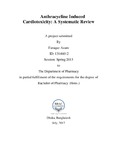| dc.contributor.advisor | Talukder, Dr. Md. Mesbah Uddin | |
| dc.contributor.author | Azam, Faruque | |
| dc.date.accessioned | 2018-02-15T10:24:24Z | |
| dc.date.available | 2018-02-15T10:24:24Z | |
| dc.date.copyright | 2017 | |
| dc.date.issued | 2017-07 | |
| dc.identifier.other | ID 13146012 | |
| dc.identifier.uri | http://hdl.handle.net/10361/9487 | |
| dc.description | This project report is submitted in partial fulfilment of the requirements for the degree of Bachelor of Pharmacy, 2017 | en_US |
| dc.description | Cataloged from PDF version of project report. | |
| dc.description | Includes bibliographical references (page 68-79). | |
| dc.description.abstract | Cancer cure currently involves a combination of integrative treatments; chemotherapy,
radiotherapy, and surgery to extend life and deliver sustainability to the survivors.
Among all the classes of chemotherapeutics, anthracycline group has multiple wellestablished
therapeutic uses. Anthracyclines can be used as antibiotics and also effective
over a wide spectrum of malignancies. However, they also possess undesired cardiac
toxicity; being the major drawback of anthracycline chemotherapy, which restricts their
clinical use. In retrospective, detrimental effects on heart associated with Anthracycline-
Induced-Cardiotoxicity (AIC) is irreversible and a challenging concern in the field of
cardio-oncology, considering other adverse effects. Despite its dose-limiting
cardiotoxicity, anthracycline drugs are being widely used in chemotherapy because of
their effectiveness over a broad spectrum of cancers and solid tumors. In addition to their
versatile therapeutic activity, dose-dependent congestive heart failure and accumulation
of toxic drug metabolites in cardiomyocytes may possibly be the worst consequences of
cardiotoxicity caused by doxorubicin and other anthracyclines. Cardiotoxicity related to
anthracyclines yet remains to be an intractable clinical conundrum for both cardiologists
and oncologists. The mechanism of AIC possibly involves oxidative stress of
myocardium triggered by free radicals and consequently may lead to apoptosis and lipid
peroxidation, or involves immunologic responses. Notably, various other mechanisms
may play an underlying role to predispose AIC. In the strategy to mitigate AIC,
dexrazoxane has shown to have promising cardioprotective action and further used to
lessen symptoms of cardiotoxicity. Although the impact of other cardioprotective agents
such as β-blockers, ACEI (Angiotensin Converting Enzyme Inhibitors), and lipid
lowering agents may reduce AIC to some degree, still significant cardiovascular
complication may occur. Despite the reduction in cumulative dose of anthracyclines and
concomitant use of iron chelator dexrazoxane, no other agent has absolute evidence in
regard to treatment or protection against AIC. In this article, we reviewed the incidence
of cardiotoxicity induced by mainly anthracyclines as well as their pathogenesis,
detection, function of biomarkers and protective agents used to ameliorate cardiovascular
complications. Besides, in particular, we found significant cardiovascular anomalies in
ADR data of doxorubicin male patients and also a notable discrepancy in ADR data of
docetaxel in different geographical regions. | en_US |
| dc.description.statementofresponsibility | Faruque Azam | |
| dc.format.extent | 79 pages. | |
| dc.language.iso | en | en_US |
| dc.publisher | BRAC University | en_US |
| dc.rights | BRAC University project reports are protected by copyright. They may be viewed from this source for any purpose, but reproduction or distribution in any format is prohibited without written permission. | |
| dc.subject | Cardiotoxicity | en_US |
| dc.subject | Anthracycline | en_US |
| dc.subject | Cancer | en_US |
| dc.title | Anthracycline induced cardiotoxicity: A systematic review | en_US |
| dc.type | Project report | en_US |
| dc.contributor.department | Department of Pharmacy, BRAC University | |
| dc.description.degree | B. Pharmacy. | |

